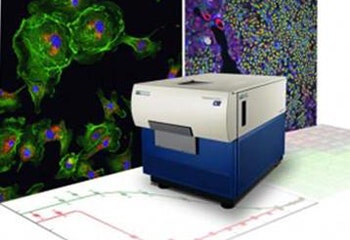
Vanderbilt Institute of Chemical Biology uses the ImageXpress Widefield system for biological screening and drug discovery
COMPANY/UNIVERSITY
Vanderbilt Institute of Chemical Biology
TEAM MEMBERS
Joshua A. Bauer, PhD, Research Assistant Professor, Director of Functional Genomics Screening and High-content Imaging
PRODUCTS USED
ImageXpress Micro XLS Widefield High-Content Analysis System
The Challenge

The Solution
High-content imaging (HCI) has been used for both basic biology research and drug discovery within the HTS facility. The ImageXpress Micro XLS System is included on an integrated robotic screening platform with full liquid handling, plate washing/dispensing, automated incubator, and more. This platform is used for imagebased HTS campaigns that are scheduled through automation software and operated remotely for streamlined data acquisition and storage. This HCI system has been widely used at Vanderbilt to screen a variety of biological models including: virus, bacteria, cells (live and fixed), tissue, tissue microarrays (TMAs), 3D culture models, and whole organisms (e.g. zebrafish).

ImageXpress Micro XLS Widefield High-Content Analysis System
Products Used
The ImageXpress Micro XLS High-Content Analysis System has been replaced by the ImageXpress Micro 4 High-Content Analysis System, which represents the culmination of four generations of imaging expertise. The latest agile design allows you to boost your research with this faster-than-ever system, while providing the option to upgrade to confocal in the future to align with your research needs.
The Result
The ImageXpress Micro XLS System is also well suited for HTS in conjunction with the large compound library collection, or to assess mechanism of action or execute target validation studies in conjunction with the siRNA libraries for functional genomic screening. Some examples that the system has screened for include: mechanisms of viral infectivity, biomarker analysis, multinucleated cells and micronuclei, cell cycle analysis, cell health, apoptosis, protein translocation, protein-protein interactions (PLA), protein expression, GPCR activation, iPS cardiomyocyte beat rates, zebrafish morphologies/phenotypes, neurite outgrowth and toxicity, antibody validation, whole-genome siRNA screening, cell-derived giant plasma membrane vesicles, RNA transcripts (RNAscope®), tumor biopsy markers and FISH, 3D tumor spheroids, drug response and synthetic lethality screens, mechanisms of action and drug combination studies.